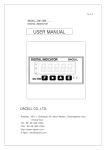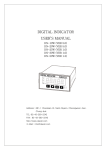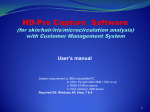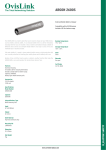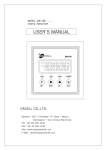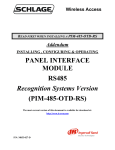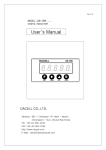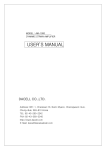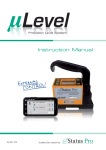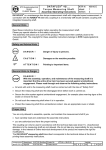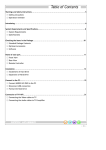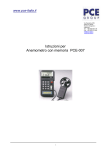Download USER MANUAL
Transcript
Ver 1.5 MODEL : DN-50W DIGITAL INDICATOR USER MANUAL DACELL CO.,LTD. Address : 681-1 Cheoksan-Ri, Nami-Myeon, Cheongweon-Gun, Chung-buk TEL :82-43-260-2242 FAX : 82-43-260-2245 http://www.dacell.com E-Mail : [email protected] Contents 1. Sepcial Features ⋅⋅⋅⋅⋅⋅⋅⋅⋅⋅⋅⋅⋅⋅⋅⋅⋅⋅⋅⋅⋅⋅⋅⋅⋅⋅⋅⋅⋅⋅⋅⋅⋅⋅⋅⋅⋅⋅⋅⋅⋅⋅⋅⋅⋅⋅⋅⋅⋅⋅⋅⋅⋅⋅⋅⋅⋅⋅⋅⋅⋅⋅⋅⋅⋅⋅⋅⋅⋅⋅⋅⋅⋅⋅⋅⋅⋅⋅⋅⋅⋅⋅⋅⋅⋅⋅⋅⋅⋅⋅⋅⋅⋅⋅⋅⋅⋅⋅⋅⋅⋅⋅⋅⋅⋅⋅⋅⋅⋅⋅⋅⋅⋅⋅⋅⋅⋅ 2 1-1. High-speed conversion method ⋅⋅⋅⋅⋅⋅⋅⋅⋅⋅⋅⋅⋅⋅⋅⋅⋅⋅⋅⋅⋅⋅⋅⋅⋅⋅⋅⋅⋅⋅⋅⋅⋅⋅⋅⋅⋅⋅⋅⋅⋅⋅⋅⋅⋅⋅⋅⋅⋅⋅⋅⋅⋅⋅⋅⋅⋅⋅⋅⋅⋅⋅⋅⋅⋅⋅⋅⋅⋅⋅⋅⋅⋅⋅⋅⋅⋅⋅⋅ 2 1-2. Calibration method ⋅⋅⋅⋅⋅⋅⋅⋅⋅⋅⋅⋅⋅⋅⋅⋅⋅⋅⋅⋅⋅⋅⋅⋅⋅⋅⋅⋅⋅⋅⋅⋅⋅⋅⋅⋅⋅⋅⋅⋅⋅⋅⋅⋅⋅⋅⋅⋅⋅⋅⋅⋅⋅⋅⋅⋅⋅⋅⋅⋅⋅⋅⋅⋅⋅⋅⋅⋅⋅⋅⋅⋅⋅⋅⋅⋅⋅⋅⋅⋅⋅⋅⋅⋅ 2 1-3. HOLD & PEAK HOLD ⋅⋅⋅⋅⋅⋅⋅⋅⋅⋅⋅⋅⋅⋅⋅⋅⋅⋅⋅⋅⋅⋅⋅⋅⋅⋅⋅⋅⋅⋅⋅⋅⋅⋅⋅⋅⋅⋅⋅⋅⋅⋅⋅⋅⋅⋅⋅⋅⋅⋅⋅⋅⋅⋅⋅⋅⋅⋅⋅⋅⋅⋅⋅⋅⋅⋅⋅⋅⋅⋅⋅⋅⋅⋅⋅⋅⋅⋅⋅⋅⋅⋅⋅⋅⋅⋅ 2 1-4. Comparison Output ⋅⋅⋅⋅⋅⋅⋅⋅⋅⋅⋅⋅⋅⋅⋅⋅⋅⋅⋅⋅⋅⋅⋅⋅⋅⋅⋅⋅⋅⋅⋅⋅⋅⋅⋅⋅⋅⋅⋅⋅⋅⋅⋅⋅⋅⋅⋅⋅⋅⋅⋅⋅⋅⋅⋅⋅⋅⋅⋅⋅⋅⋅⋅⋅⋅⋅⋅⋅⋅⋅⋅⋅⋅⋅⋅⋅⋅⋅⋅⋅⋅⋅⋅⋅⋅⋅⋅ 2 1-5. Data Back-up ⋅⋅⋅⋅⋅⋅⋅⋅⋅⋅⋅⋅⋅⋅⋅⋅⋅⋅⋅⋅⋅⋅⋅⋅⋅⋅⋅⋅⋅⋅⋅⋅⋅⋅⋅⋅⋅⋅⋅⋅⋅⋅⋅⋅⋅⋅⋅⋅⋅⋅⋅⋅⋅⋅⋅⋅⋅⋅⋅⋅⋅⋅⋅⋅⋅⋅⋅⋅⋅⋅⋅⋅⋅⋅⋅⋅⋅⋅⋅⋅⋅⋅⋅⋅⋅⋅⋅⋅⋅⋅⋅ 2 1-6. Watch dog ⋅⋅⋅⋅⋅⋅⋅⋅⋅⋅⋅⋅⋅⋅⋅⋅⋅⋅⋅⋅⋅⋅⋅⋅⋅⋅⋅⋅⋅⋅⋅⋅⋅⋅⋅⋅⋅⋅⋅⋅⋅⋅⋅⋅⋅⋅⋅⋅⋅⋅⋅⋅⋅⋅⋅⋅⋅⋅⋅⋅⋅⋅⋅⋅⋅⋅⋅⋅⋅⋅⋅⋅⋅⋅⋅⋅⋅⋅⋅⋅⋅⋅⋅⋅⋅⋅⋅⋅⋅⋅⋅⋅⋅⋅⋅⋅⋅⋅⋅⋅⋅⋅⋅⋅⋅⋅⋅⋅⋅⋅⋅⋅⋅⋅⋅⋅⋅ 2 1-7. Option ⋅⋅⋅⋅⋅⋅⋅⋅⋅⋅⋅⋅⋅⋅⋅⋅⋅⋅⋅⋅⋅⋅⋅⋅⋅⋅⋅⋅⋅⋅⋅⋅⋅⋅⋅⋅⋅⋅⋅⋅⋅⋅⋅⋅⋅⋅⋅⋅⋅⋅⋅⋅⋅⋅⋅⋅⋅⋅⋅⋅⋅⋅⋅⋅⋅⋅⋅⋅⋅⋅⋅⋅⋅⋅⋅⋅⋅⋅⋅⋅⋅⋅⋅⋅⋅⋅⋅⋅⋅⋅⋅⋅⋅⋅⋅⋅⋅ 3 1-8. Power ⋅⋅⋅⋅⋅⋅⋅⋅⋅⋅⋅⋅⋅⋅⋅⋅⋅⋅⋅⋅⋅⋅⋅⋅⋅⋅⋅⋅⋅⋅⋅⋅⋅⋅⋅⋅⋅⋅⋅⋅⋅⋅⋅⋅⋅⋅⋅⋅⋅⋅⋅⋅⋅⋅⋅⋅⋅⋅⋅⋅⋅⋅⋅⋅⋅⋅⋅⋅⋅⋅⋅⋅⋅⋅⋅⋅⋅⋅⋅⋅⋅⋅⋅⋅⋅⋅⋅⋅⋅⋅⋅⋅⋅⋅⋅⋅⋅ 3 2. Attention ⋅⋅⋅⋅⋅⋅⋅⋅⋅⋅⋅⋅⋅⋅⋅⋅⋅⋅⋅⋅⋅⋅⋅⋅⋅⋅⋅⋅⋅⋅⋅⋅⋅⋅⋅⋅⋅⋅⋅⋅⋅⋅⋅⋅⋅⋅⋅⋅⋅⋅⋅⋅⋅⋅⋅⋅⋅⋅⋅⋅⋅⋅⋅⋅⋅⋅⋅⋅⋅⋅⋅⋅⋅⋅⋅⋅⋅⋅⋅⋅⋅⋅⋅⋅⋅⋅⋅⋅⋅⋅⋅⋅⋅⋅⋅⋅⋅⋅⋅⋅⋅⋅⋅⋅⋅⋅⋅⋅⋅⋅ 4 2-1. Attention for installation ⋅⋅⋅⋅⋅⋅⋅⋅⋅⋅⋅⋅⋅⋅⋅⋅⋅⋅⋅⋅⋅⋅⋅⋅⋅⋅⋅⋅⋅⋅⋅⋅⋅⋅⋅⋅⋅⋅⋅⋅⋅⋅⋅⋅⋅⋅⋅⋅⋅⋅⋅⋅⋅⋅⋅⋅⋅⋅⋅⋅⋅⋅⋅⋅⋅⋅⋅⋅⋅⋅⋅⋅⋅⋅⋅⋅⋅⋅⋅⋅⋅⋅⋅⋅⋅⋅⋅⋅⋅⋅⋅⋅ 4 2-2. Attention for use ⋅⋅⋅⋅⋅⋅⋅⋅⋅⋅⋅⋅⋅⋅⋅⋅⋅⋅⋅⋅⋅⋅⋅⋅⋅⋅⋅⋅⋅⋅⋅⋅⋅⋅⋅⋅⋅⋅⋅⋅⋅⋅⋅⋅⋅⋅⋅⋅⋅⋅⋅⋅⋅⋅⋅⋅⋅⋅⋅⋅⋅⋅⋅⋅⋅⋅⋅⋅⋅⋅⋅⋅⋅⋅⋅⋅⋅⋅⋅⋅⋅⋅⋅⋅⋅⋅⋅⋅⋅⋅⋅ 4 3. Specification ⋅⋅⋅⋅⋅⋅⋅⋅⋅⋅⋅⋅⋅⋅⋅⋅⋅⋅⋅⋅⋅⋅⋅⋅⋅⋅⋅⋅⋅⋅⋅⋅⋅⋅⋅⋅⋅⋅⋅⋅⋅⋅⋅⋅⋅⋅⋅⋅⋅⋅⋅⋅⋅⋅⋅⋅⋅⋅⋅⋅⋅⋅⋅⋅⋅⋅⋅⋅⋅⋅⋅⋅⋅⋅⋅⋅⋅⋅⋅⋅⋅⋅⋅⋅⋅⋅⋅⋅⋅⋅⋅⋅⋅⋅⋅⋅⋅⋅⋅⋅⋅⋅⋅⋅⋅⋅⋅⋅⋅⋅⋅⋅⋅⋅⋅⋅⋅⋅⋅ 5 4. Front Panel ⋅⋅⋅⋅⋅⋅⋅⋅⋅⋅⋅⋅⋅⋅⋅⋅⋅⋅⋅⋅⋅⋅⋅⋅⋅⋅⋅⋅⋅⋅⋅⋅⋅⋅⋅⋅⋅⋅⋅⋅⋅⋅⋅⋅⋅⋅⋅⋅⋅⋅⋅⋅⋅⋅⋅⋅⋅⋅⋅⋅⋅⋅⋅⋅⋅⋅⋅⋅⋅⋅⋅⋅⋅⋅⋅⋅⋅⋅⋅⋅⋅⋅⋅⋅⋅⋅⋅⋅⋅⋅⋅⋅⋅⋅⋅⋅⋅⋅⋅⋅⋅⋅⋅⋅⋅⋅⋅⋅⋅ 6 5. Rear Panel ⋅⋅⋅⋅⋅⋅⋅⋅⋅⋅⋅⋅⋅⋅⋅⋅⋅⋅⋅⋅⋅⋅⋅⋅⋅⋅⋅⋅⋅⋅⋅⋅⋅⋅⋅⋅⋅⋅⋅⋅⋅⋅⋅⋅⋅⋅⋅⋅⋅⋅⋅⋅⋅⋅⋅⋅⋅⋅⋅⋅⋅⋅⋅⋅⋅⋅⋅⋅⋅⋅⋅⋅⋅⋅⋅⋅⋅⋅⋅⋅⋅⋅⋅⋅⋅⋅⋅⋅⋅⋅⋅⋅⋅⋅⋅⋅⋅⋅⋅⋅⋅⋅⋅⋅⋅⋅⋅⋅⋅⋅⋅⋅ 7 6. Wiring Diagram⋅⋅⋅⋅⋅⋅⋅⋅⋅⋅⋅⋅⋅⋅⋅⋅⋅⋅⋅⋅⋅⋅⋅⋅⋅⋅⋅⋅⋅⋅⋅⋅⋅⋅⋅⋅⋅⋅⋅⋅⋅⋅⋅⋅⋅⋅⋅⋅⋅⋅⋅⋅⋅⋅⋅⋅⋅⋅⋅⋅⋅⋅⋅⋅⋅⋅⋅⋅⋅⋅⋅⋅⋅⋅⋅⋅⋅⋅⋅⋅⋅⋅⋅⋅⋅⋅⋅⋅⋅⋅⋅⋅⋅ 9 7. Components & Function ⋅⋅⋅⋅⋅⋅⋅⋅⋅⋅⋅⋅⋅⋅⋅⋅⋅⋅⋅⋅⋅⋅⋅⋅⋅⋅⋅⋅⋅⋅⋅⋅⋅⋅⋅⋅⋅⋅⋅⋅⋅⋅⋅⋅⋅⋅⋅⋅⋅⋅⋅⋅⋅⋅⋅⋅⋅⋅⋅⋅⋅⋅⋅⋅⋅⋅⋅⋅⋅⋅⋅⋅⋅⋅⋅⋅⋅⋅⋅⋅⋅⋅⋅⋅⋅⋅⋅⋅⋅⋅⋅⋅⋅⋅⋅⋅⋅⋅⋅⋅⋅⋅⋅⋅⋅ 10 7-1. Flow Chart ⋅⋅⋅⋅⋅⋅⋅⋅⋅⋅⋅⋅⋅⋅⋅⋅⋅⋅⋅⋅⋅⋅⋅⋅⋅⋅⋅⋅⋅⋅⋅⋅⋅⋅⋅⋅⋅⋅⋅⋅⋅⋅⋅⋅⋅⋅⋅⋅⋅⋅⋅⋅⋅⋅⋅⋅⋅⋅⋅⋅⋅⋅⋅⋅⋅⋅⋅⋅⋅⋅⋅⋅⋅⋅⋅⋅⋅⋅⋅⋅⋅⋅⋅⋅⋅⋅⋅⋅⋅⋅⋅⋅⋅⋅⋅⋅⋅⋅⋅⋅⋅⋅⋅⋅⋅⋅⋅ 10 7-2. How to use Hold mode ⋅⋅⋅⋅⋅⋅⋅⋅⋅⋅⋅⋅⋅⋅⋅⋅⋅⋅⋅⋅⋅⋅⋅⋅⋅⋅⋅⋅⋅⋅⋅⋅⋅⋅⋅⋅⋅⋅⋅⋅⋅⋅⋅⋅⋅⋅⋅⋅⋅⋅⋅⋅⋅⋅⋅⋅⋅⋅⋅⋅⋅⋅⋅⋅⋅⋅⋅⋅⋅⋅⋅⋅⋅⋅ 11 7-3. How to use comparison output function ⋅⋅⋅⋅⋅⋅⋅⋅⋅⋅⋅⋅⋅⋅⋅⋅⋅⋅⋅⋅⋅⋅⋅⋅⋅⋅⋅⋅⋅⋅⋅⋅⋅⋅⋅⋅⋅⋅⋅⋅⋅⋅⋅⋅⋅⋅⋅⋅⋅⋅⋅⋅⋅⋅⋅⋅⋅⋅⋅⋅⋅⋅⋅⋅⋅⋅⋅⋅⋅ 12 8. Setting mode ⋅⋅⋅⋅⋅⋅⋅⋅⋅⋅⋅⋅⋅⋅⋅⋅⋅⋅⋅⋅⋅⋅⋅⋅⋅⋅⋅⋅⋅⋅⋅⋅⋅⋅⋅⋅⋅⋅⋅⋅⋅⋅⋅⋅⋅⋅⋅⋅⋅⋅⋅⋅⋅⋅⋅⋅⋅⋅⋅⋅⋅⋅⋅⋅⋅⋅⋅⋅⋅⋅⋅⋅⋅⋅⋅⋅⋅⋅⋅⋅⋅⋅⋅⋅⋅⋅⋅⋅⋅⋅⋅⋅⋅⋅⋅ 14 8-1. Types of Setting mode & Set-up ⋅⋅⋅⋅⋅⋅⋅⋅⋅⋅⋅⋅⋅⋅⋅⋅⋅⋅⋅⋅⋅⋅⋅⋅⋅⋅⋅⋅⋅⋅⋅⋅⋅⋅⋅⋅⋅⋅⋅⋅⋅⋅⋅⋅⋅⋅⋅⋅⋅⋅⋅⋅⋅⋅⋅⋅⋅⋅⋅⋅⋅⋅⋅⋅⋅⋅⋅⋅⋅⋅⋅⋅⋅⋅⋅⋅⋅⋅⋅⋅⋅⋅⋅ 14 8-2. Function mode (Function Set-up) ⋅⋅⋅⋅⋅⋅⋅⋅⋅⋅⋅⋅⋅⋅⋅⋅⋅⋅⋅⋅⋅⋅⋅⋅⋅⋅⋅⋅⋅⋅⋅⋅⋅⋅⋅⋅⋅⋅⋅⋅⋅⋅⋅⋅⋅⋅⋅⋅⋅⋅⋅⋅⋅⋅⋅⋅⋅⋅⋅⋅⋅⋅⋅⋅⋅⋅⋅⋅ 15 8-3. Digital calibration (Calibration by sensor output value) ⋅⋅⋅⋅⋅⋅⋅⋅⋅⋅⋅⋅⋅⋅⋅⋅⋅⋅⋅⋅⋅⋅⋅⋅⋅⋅⋅⋅⋅⋅⋅⋅⋅⋅⋅⋅⋅⋅⋅⋅⋅⋅⋅ 22 8-4.Real-weight Calibration ⋅⋅⋅⋅⋅⋅⋅⋅⋅⋅⋅⋅⋅⋅⋅⋅⋅⋅⋅⋅⋅⋅⋅⋅⋅⋅⋅⋅⋅⋅⋅⋅⋅⋅⋅⋅⋅⋅⋅⋅⋅⋅⋅⋅⋅⋅⋅⋅⋅⋅⋅ 23 8-5. Calibration by Shunt CAL value ⋅⋅⋅⋅⋅⋅⋅⋅⋅⋅⋅⋅⋅⋅⋅⋅⋅⋅⋅⋅⋅⋅⋅⋅⋅⋅⋅⋅⋅⋅⋅⋅⋅⋅⋅⋅⋅⋅⋅⋅⋅⋅⋅⋅⋅⋅⋅⋅⋅⋅⋅⋅⋅⋅⋅⋅⋅⋅⋅⋅⋅⋅⋅⋅ 24 8-6. Data Back-up & Restore ⋅⋅⋅⋅⋅⋅⋅⋅⋅⋅⋅⋅⋅⋅⋅⋅⋅⋅⋅⋅⋅⋅⋅⋅⋅⋅⋅⋅⋅⋅⋅⋅⋅⋅⋅⋅⋅⋅⋅⋅⋅⋅⋅⋅⋅⋅⋅⋅⋅⋅⋅⋅⋅⋅⋅⋅⋅⋅⋅⋅⋅⋅⋅⋅ 25 8-7. Lock Set-up⋅⋅⋅⋅⋅⋅⋅⋅⋅⋅⋅⋅⋅⋅⋅⋅⋅⋅⋅⋅⋅⋅⋅⋅⋅⋅⋅⋅⋅⋅⋅⋅⋅⋅⋅⋅⋅⋅⋅⋅⋅⋅⋅⋅⋅⋅⋅⋅⋅⋅⋅⋅⋅⋅⋅⋅⋅⋅⋅⋅⋅⋅⋅⋅⋅⋅⋅⋅⋅⋅⋅⋅⋅⋅⋅⋅⋅⋅⋅⋅⋅⋅⋅⋅⋅⋅⋅⋅⋅⋅ 26 9. Product Inspection ⋅⋅⋅⋅⋅⋅⋅⋅⋅⋅⋅⋅⋅⋅⋅⋅⋅⋅⋅⋅⋅⋅⋅⋅⋅⋅⋅⋅⋅⋅⋅⋅⋅⋅⋅⋅⋅⋅⋅⋅⋅⋅⋅⋅⋅⋅⋅⋅⋅⋅⋅⋅⋅⋅⋅⋅⋅⋅⋅⋅⋅⋅⋅⋅⋅⋅⋅⋅⋅⋅⋅⋅⋅⋅⋅⋅⋅⋅⋅⋅⋅⋅⋅⋅⋅⋅⋅⋅⋅⋅⋅⋅⋅⋅⋅⋅⋅⋅⋅⋅⋅⋅⋅ 27 10. OPTION (OP-02, OP-03) Option 02 (RS232C) ⋅⋅⋅⋅⋅⋅⋅⋅⋅⋅⋅⋅⋅⋅⋅⋅⋅⋅⋅⋅⋅⋅⋅⋅⋅⋅⋅⋅⋅⋅⋅⋅⋅⋅⋅⋅⋅⋅⋅⋅⋅⋅⋅⋅⋅⋅⋅⋅⋅⋅⋅⋅⋅⋅⋅⋅⋅⋅⋅⋅⋅⋅⋅⋅⋅⋅⋅⋅⋅⋅⋅⋅⋅⋅⋅⋅⋅⋅⋅⋅⋅⋅⋅⋅⋅⋅⋅⋅⋅⋅⋅⋅⋅⋅⋅⋅⋅⋅⋅⋅⋅⋅⋅ 28 Option 03 (RS485) ⋅⋅⋅⋅⋅⋅⋅⋅⋅⋅⋅⋅⋅⋅⋅⋅⋅⋅⋅⋅⋅⋅⋅⋅⋅⋅⋅⋅⋅⋅⋅⋅⋅⋅⋅⋅⋅⋅⋅⋅⋅⋅⋅⋅⋅⋅⋅⋅⋅⋅⋅⋅⋅⋅⋅⋅⋅⋅⋅⋅⋅⋅⋅⋅⋅⋅⋅⋅⋅⋅⋅⋅⋅⋅⋅⋅⋅⋅⋅⋅⋅⋅⋅⋅⋅⋅⋅⋅⋅⋅⋅⋅⋅⋅⋅⋅⋅⋅⋅⋅⋅⋅⋅ 30 1 1. Special Features We thank you for using our product. Please refer to this manual or contact our office if you find any problems during using our product. This product is an indicator that emplifies the micro voltage signals from each sensor and display in digital. It is mainly used to measure physical quantities of the items using strain guage such as loadcell, pressure sensor, displacement sensor and torque sensor. This product has the following special features. 1-1. High-speed Conversion Method 24bit High-speed A/D converter that can detect the sensor’s input signal at a rate of 1000times per second is used. For analog output, 16bit D/A converter with 1000times per second is used so that there is almost no devuatuib betweeb display value and output value. 1-2. Calibration Method 2 types of calibration systems are adopted. Calibration by actual load (standard weight) and calibration by rated output of sensor (mV/V). 1-3. Hold and Peak Hold You can choose Analog peak hold (High-speed) or Digital preak hold (Low-speed) as per your need. 1-4. Comparison Output You can do set-up the maxium and lower limit value by the keys on the front panel and output contact point signal of the rear panel. 1-5. Data Back-up All the set-up values will be memorized on the flash memory so the inputted data can be saved and no need to do the re-setting even in case of the interruption of the electric power or power disconnection. 1-6. Watch dog This function is for automatic reset in case the system is stopped due to the external factors such as noise. 2 1-7. Option You can use RS232C, RS485 and 4 relay output as the optional specification. 1-8. Power AC 85 ~ 265V 50/60Hz Free voltage 3 2. Attention For the efficient and safe use, please carefully read and be fully aware of the following details before using this product. It is strictly forbidden to use this product for any other purpose of use or to attempt to make any alteration on this product. 2-1. Attention for installation • Please keep it out of wet places. • Do not set it up near vibration & impulse, high temperature and humidity. Keep it out of the direct rays of the sun. Set it up where there is less dust, and Keep it out of direct air including salt and ion. • Do not use when there is inflammable gas or heavy machinery, and smog. • Ground earth-terminal ( ). • Make wire separately from power system wiring and noise wiring. • Make sure the use of 4 line sealed cable as a sensor cable. Too long cable leads to measurement error due to wiring resistance (around 10meters). 2-2. Attention for use During calibration, Do not input free-load state and real-weight load until it becomes stable. Pressing Enter Key in unstable condition leads to calibration error. Do not press any Key in use at one's discretion. Please refer to 7. Setting-up mode for the function and method of Key. 4 3. Specification • • • • • • • • • • • • • Available sensor : Strain Gauge sensor (Bridge 120Ω, 350Ω, 700Ω) Upper limit Display : -19999 ~ +99999 A/D Converter : 24bit, 1000 times/sec D/A Converter : 16bit, 1000 times/sec Temperature Characteristic (Amp Characteristic) Zero : 0.5μV/℃ Span : 50ppm/℃ Front Panel Measured value display : 7 segment 5 Digit, Character Height 14mm Status display : Red LED 3 pcs Key Switch : 4 pcs Output Comparison output : Upper limit(HI), Lower limit(LO), Normal(OK) Output Contact Capacity - AC 125V 0.5A/ DC 24V 1A Analog Output : DC 0~10V/4~20mA (Optional at the time of order) Temperature range for use: -10℃~ 60, >82% RH (No dewing) External dimension : 96 × 48 × 128 mm (W × H × D) Panel cutting size : 91 × 45 mm Weight : About 450g Power Supply : AC 85 ~ 265V, 50/60㎐ Option : 4~20mA(OP-1), RS232C (OP-02), RS485 (OP-03) 5 4. Front Panel ① HI, LO Indication LED : Hi or LO LED will be lighted when measured value exceeds the setting value. ② HOLD indication LED : This LED will be lighted when the measured value is on Hold. ③ Measured value Indication: It indicates the measured value and each setting value. ④ ZERO/SPAN setting up VR : It is used when ZERO and SPAN calibration of Analog output (DC 0 ~ 10V or 4 ~ 20mA) is carried out. ⑤ Measruing Mode: Once this Key is pressed for more than 1 second, the current measuring value will be Zero (0) and the Analog output will be 0V (4mA) as well. SET-UP Mode: Once this is pressed on the Function Set-up Mode, you will return to the measuring mode. ⑥ Measuring Mode: Once this Key is pressed, the lower limit setting value will be displayed and this value also can be changed. SET-UP Mode: The location of row for the number flickering can be moved. ⑦ Measuring Mode: Once this Key is pressed, the upper limit setting value will be displayed and the value can be changed. SET-UP Mode: The flickering number will be increased by 1 and 1. ⑧ Measuring Mode: Once this Key is pressed, HOLD will be selected and once this key is pressed again, HOLD will be cancelled. SET-UP Mode: Save each set-up value. 6 5. Rear Panel Please check the location of terminal and its use. While the projected button is being pressed, please insert the cable into the lower hole completely. As soon as you release the button, the connection will be completed. At the point, please slightly pull the calbe and check whether the cable is come off or not. (The most suitable calbe is Φ 0.5~1. Linking cable must be brazing or used with 1 terminal) ① AC IN ② ③ ④ ⑤ ⑥ ⑦ ⑧ ⑨ ⑩ ⑪ ⑪ ⑫ ⑬ ⑭ : Main Power Supply Wiring Terminal : Ground Terminal (as an independent ground connection.) OUT : Analog (DC 0 ~10V/DC 4 ~ 20mA) Output Terminal EXC+ : Sensor Supply Voltage + Connection Terminal EXC: Sensor Supply Voltage + Connection Terminal SIG+ : Sensor Ouput Signal + Connection Terminal SIG: Sensor Output Signal – Connection Terminal GND : SHIELD connection terminal of sensor GND, TXD, RXD : RS232C SERIAL INTERFACE (RS485 : TXD → TX+, RXD → TX-) GND : External Input Common Terminal IN1 : External HOLD Input Terminal IN1 : External HOLD Input Terminal IN2 : External ZERO Input Terminal IN3 : External printer signal Input Terminal (when PT-100 use) IN4 : No use 7 ⑮ 16 ○ 17 ○ 18 ○ 19 ○ 20 ○ COM RY1 RY2 RY3 RY4 ANALOG SW1 SW2 SW3 : RELAY Output Common Terminal : RELAY 1(Lower Limit) Output Terminal : RELAY2 (Upper Limit) Output Terminal : RELAY3( Normal) Output Terminal (OK ) : RELAY 4 Output Terminal OUT LOW PASS FILTER (10Hz, 100Hz, 1 kHz) Selet Switch : 10Hz : 100Hz : 1kHz ◀Attention▶ 1. When wiring, please pull out the power plug. (Main power supply) 2. Please use the thick calbe for ground terminal ( ) so that you can avoid any trouble due to the impulse voltage or surge. If possible, please keep it as an independent ground. (This must be used in the area with heavy noise. If the ground is made with other device, it will be affected by noise.) 3. Please check the function of the terminal before you do the wiring so that you can prevent any malfunction in advance. 4. Manufacture will be relieved of its responsibility for any damge or injury due to the disassembly and alteration made without any agreement. Also, no A/S will be made. 8 6. Wiring Diagram <Wiring Diagram> <Example - External Input PLC Connection> 9 7. Components & Function 7-1. Flow Chart sensor input Analog peak hold circuit A/D conversion 1000 times/s D/A conversion 1000 times/s Fixed filter Average : 32 times Output count : 32 times/s Display filter Display update rate : 1~32times/s Average : 1 ~ 32times/s Display peak hold Display D/A conversion circuit 1 ~32 times/s Display Analog output Comparator Relay output OP-02(RS232C) Serial output OP-03(RS485) 10 7-2. How to use Hold mode Hold mode is largely divided into Peak Hold and Sample Hold. Please select Analog, Digital or Display Hold as per your purpose of use (Hi or Low Speed) To input Hold, you can use Hold key on the front panel or external input. For the operation method, please refer to the drawing below. 1) Peak Hold : To Hold the maxium value among the measured values. Analog peak hold mode : It is a high-speed Peak hold. It is to hold and display the maximum value of (+) direction. Display peak hold mode : It is a low-sped Peak hold. It is to hold and display the maximum value of (+) direction. Absolute peak hold mode : It is a low-speed Peak hold. It is to hold and display the maximum value of the absolute value (+/-). 2) Sample hold : It is to hold and display the value at the time of Hold signal input among the measured values. Digital sample hold mode : It is operated by high-speed sample hold. Display sample hold mode : It is operated by low-speed sample hold. e u l a v d e r u s a e M ② − : Display value & Analog ouput value e u l a v d e r u s a e M ① − : Sensor input value ② ① Time Front Panel HOLD LED External HOLD Input Terminal ① ② Time On Off On Off On Front Panel HOLD Key off <Peak HOLD> 11 <Sample HOLD> 7-3. How to use comparison ouput function For comparison output function, there are 3 different modes such as Decision, High limit, Low limit. It displays through the relay of rear panel comparing each setup value. On High limit and Low limit mode, Hysteresis can be used. To set up upper limit (High) and lower limit(Low), please use the key on the front panel. 1) Decision mode : Measured Value ≤ Lower limit setup value ⇒ RY1 ON (HI) Measured Value ≥ Upper limit setup value ⇒ RY2 ON (LO) Lower limit setup value < Measured value < Upper limit setup value ⇒ RY3 ON (OK) 2) High limit mode : Measured Value ≥ RY1 setup value ⇒ RY1 ON Measured Value ≥ RY2 setup value ⇒ RY2 ON Measured Value ≥ RY3 setup value ⇒ RY3 ON Measured Value ≥ RY4 setup value ⇒ RY4 ON Measured Value < RY1 setup value – Hysteresis value⇒ RY1 OFF Measured Value< RY2 setup value - Hysteresis value⇒ RY2 OFF Measured Value < RY3 setup value – Hysteresis value⇒ RY3 OFF Measured Value< RY4 setup value - Hysteresis value⇒ RY4OFF 3) Low limit mode : Measured Value ≤ RY1 setup value ⇒ RY1 ON Measured Value ≤ RY2 setup value ⇒ RY2 ON Measured Value ≤ RY3 setup value ⇒ RY3 ON Measured Value ≤ RY4 setup value ⇒ RY4 ON Measured Value > RY1 setup value + Hysteresis value⇒ RY1 OFF Measured Value > RY2 setup value + Hysteresis value⇒ RY2 OFF Measured Value > RY3 setup value + Hysteresis value⇒ RY3 OFF Measured Value > RY4 setup value + Hysteresis value⇒ RY4 OFF 4) Low & High limit mode Measured Value ≤ RY1 setup value ⇒ RY1 ON Measured Value ≤ RY2 setup value ⇒ RY2 ON Measured Value ≥ RY3 setup value ⇒ RY3 ON Measured Value ≥ RY4 setup value ⇒ RY4 ON Measured Value > RY1 setup value + Hysteresis value ⇒ RY1 OFF Measured Value > RY2 setup value + Hysteresis value ⇒ RY2 OFF Measured Value < RY3 setup value - Hysteresis value ⇒ RY3 OFF Measured Value < RY4 setup value - Hysteresis value ⇒ RY4 OFF 12 13 8. Setting Modes 8-1. Types of Setting mode & Set-up For Setting mode, there are 3 different types of mode such as Function mode, Digital calibration mode and Actual load calibration mode. Measuring Mode While key pressed, press is being key. Function mode ① END Digital calibration mode ② END Actual load calibration mode ③ END SPAN constant calibration mode ④ END ① Function mode: Access to each function setup mode. Please refer 8-2 Function Mode. ② Digital calibration mode: It is to calibrate into the sensor’s output value. No need to prepare for the actual load (standard weight). ③ Actual load calibration mode: Please refer 8-3 How to calibrate. It is to calibrate by adding the actual load (Standard weight or the load you know). Please refer 8-4 How to calibrate. ④ SPAN constant calibration mode: It is to calibrate with the S.CAL value written down for load calibration. Please refer 8-5 How to calibrate. 14 8-2. Function mode 1) How to set function. Measuring Mode State While key is being pressed, press key. END 15 2) How to set RELAY data ① Decision mode (Decision mode : mode 0) ② Limit mode (Low & High limit mode: mode 1 ~ 3) Measuring Mode press key Input data END 16 # Function mode list # The standard setName Function up value at the Setting time of delivery from the factory F-01 Decimal point 0, 1, 2, 3 1 F-02 Division 1, 2, 5, 10, 20, 50 1 F-03 Display filter 0, 4, 8, 16, 32 8 F-04 Hold mode F-05 Comparison mode Decision, High limit, Low limit F-06 Hysteresis 0 ~ 99 F-07 DAC mode Display DAC, High speed DAC F-08 DAC capacity -19999 ~ +99999 F-09 ID Number 0 ~ 32 Baud rate 2400, F-10 Display SH, Digital SH, Display PH(+), Absolute PH(±), Analog PH(+) Display PH(+) Decision 0 Display DAC 10000 0 4800, 9600, 19200, 38400, 57600 9600 F-11 Auto zero tracking 0 ~ 99 0 F-12 Auto zero tracking time 0.0 ~ 5.0 sec 0.0 F-13 Force unit Kg(kg/㎠), N, ℓb, bar, MPa Kg F-14 Key disabling Zero key, Lo key, Hi key, Hold key 0000 F-01. Decimal point (Decimal point Set-up) (Standard setup value : 1) Display data Setting 0 00000 : No decimal point 1 0000.0 : One decimal place 2 000.00 : Two decimal places 3 00.000 : Three decimal places 17 F-02. Division (Minimum display unit setup) (Standard setup value : 1) Display data Setting 1 Displayed In 1 (0, 1, 2, 3, 4 …….) 2 Displayed in 2 (0, 2, 4, 6, 8 …….) 5 Displayed in 5 (0, 5, 10, 15 …….) 10 Displayed in 10 (0, 10, 20, 30 …….) 20 Displayed in 20 (0, 20, 40, 60 …….) 50 Displayed in 50 (0, 50, 100, 150 …….) F-03. Display filter (Display speed setup) (Standard setup value : 8) Display data Setting 0 No filter 4 Average time 1/8 sec 8 Average time 1/4 sec 16 Average time 1/2 sec 32 Average time 1 sec F-04. Hold mode Display data Setting 0 Display sample Hold : To hold the display value at the time of Hold signal input. 1 Digital sample Hold : To hold the A/D convertion value at the time of Hold signal input. 2 Diplay Peak Hold : To hold the maximum value of display values during Hold signal input. 3 Absolute Peak Hold : To hold the maximum absolute value of display values during Hold signal input. 4 Analog Peak Hold : To hold the maximum value of sensor input during Hold signal input. F-05. Comparision mode (Comparision output mode setup (Standard setup value : 0) Display data Setting 0 Decision mode : Relay RY1(Lo), RY2(Hi), RY3(Ok) Output 1 High limit mode : Relay RY1, RY2, RY3, RY4 output 2 Low limit mode : Relay RY1, RY2, RY3, RY4 output 3 Low & High limit mode : Relay RY1, RY2, RY3, RY4 output 18 F-06. Hysteresis (Standard setup value : 00) Display data 00 ~ 99 Setting 00 : Hysteresis – not used 01 ~99 : Hysteresis – used (Decision mode is not applied) F-07. DAC mode (Analog Output mode setup) (Standard setup value : 0) Display data Setting 0 Display DAC mode Convert the current display value and the do the analog output. 1 High speed DAC mode Convert A/D input value and do the analog output. F-08. DAC capacity (Analog Outupt value setup) (Standard setup value : 10000) Display data -19999 ~ +99999 Setting To setup the rated capacity of analog output <Example of Setup value and output> Setup Value +10000 -10000 Voltage Outupt (±10V) Current Output (4 ~20mA) Display Value Output Display Value Output -10000 -10V -10000 - 0 0V 0 4mA +10000 +10V +10000 20mA -10000 +10V -10000 20mA 0 0V 0 4mA +10000 -10V +10000 - 1 F-09. ID Number (Communication Device Number setup) (Standard setup value : 00) Display data 00 ~ 32 Setting 00 : Device number is not set-up (Stream mode : always transmit data ) 01 ~32 : Device number is set-up (Command mode : Transmit data by command) 19 F-10. Baud rate (Communication Speed Setup) (Standard setup value : 9.60) Display data Setting Stream mode Command mode 2.40 2400 bps O O 4.80 4800 bps O O 9.60 9600 bps O O 19.20 19200 bps O X 38.40 38400 bps O X 57.60 57600 bps O X PRINT PRINT DATA OUT (PT-100) - - F-11. Auto zero tracking (Auto zero operation range setup) (Standard setup value : 00) Display data 00 ~ 99 Setting 00 : Auto Zero is not used. 01 ~99 : Set up the operation range of auto zero F-12. Auto zero tracking time (Auto Zero tracking time setup) (Standard setup value : 0.0) Display data 00 ~ 5.0 Setting 0.0 : Auto Zero is not used. 0.1 ~5.0 : Set up the auto zero operation time (0.1 ~ 5.0 sec) F-13. Force unit (Conversion Unit setup) (Standard setup value : 0) Display data Setting 0 kg.f kg/㎠ 1 N kgf × 9.8 - - 2 ℓb kgf × 2.2 - - 3 - - Bar kg/㎠ × 0.98 4 - - MPa kg/㎠ × 0.098 Note) During calibration, set up the unit you want after calibrating it into Kg. 20 F-14. Key disabling (Front key Locking setup) (Standard setup value : 0000) Display data 0 0 0 0 Setting Hold key Lock (1), Release (0) Hi key Lock (1), Release (0) Lo key Lock (1), Release (0) Zero key Lock (1), Release (0) <Set-up example> 1001 : Zero & Hold key Lock, Hi and Lo key Release 21 8-3. Digital calibration (Calibration by sensor output value) At the time of purchasing sensor, the rated capacity (R.C) and rated output (R.O) declared on the calibration sheet can be used for the calibration for easier calibration. Measuring Mode State While key is being pressed, press key. Displays Function Mode State Displays Sensor Output Calibration State Displays Rated Output value Input State Input the rated output value by using key. And then, press and key. Displays the rated capacity value Input State Input the rated capacity value by using key. And then press key. Calibration Completed. 22 and 8-4. Actual load calibration This is a calibration method by adding actual load on the sensor. Standard weight is Needed. Measuring Mode State eeded. While key is being pressed, press key. Displays Function Mode State Displays Sensor Ouput Value Calibration State Displays Actual Load Calibration State Displays the Rated output value input state Input the rated output value by using and key. And then, press key. (Input 3.0000 if donot know the rated output of sensor) Displays Zero State Press key without adding any load on the sensor (Zero Emission) About 1 second later, Displays the acual load State Input the actual load (standard weight) by using And then press and key. key. After adding the actual load (standard weight) on the sensor, press After about 1 sec for display, Displays Shunt CAL Value (Please write to S.CAL) DATE Calibration Completed. 23 Rated output S.CAL key. 8-5. Calibratuib by Shunt CAL Value It is to calibrate with the S.CAL value written down for load calibration. You can calibrate without any standard weight. Measuring Mode State While key is being pressed, press key. Displays Function Mode State Displays Sensor Ouput Value Calibration State Displays Actual Load Calibration State Displays Shunt cal value Calibration state Displays the Rated output value input state Input the rated output value by using and key. And then, press key. (Input 3.0000 if donot know the rated output of sensor) Displays Shunt cal value input State Input S.CAL value by using Calibration Completed. 24 and key. And then press key. 8-6. DATA BACK-UP & RESTORE You can save all the set-up values of the device and then restore them to the current set-up state as per your need. ◦ DATA BACK-UP : Save the current set-up state. ◦ RESTORE : Restore the current set-up state. 25 1) DATA BACK-UP Measuring Mode State While key is being pressed, press key. After 1 sec for display, Display Please select YES or NO by using YES : SAVE DATA. key. NO : Do not save DATA. 2) RESTORE Power is OFF While key is being pressed, turn the power On. After 1 sec for display, Display Please select YES or NO by using YES : Restore DATA . key. NO : Do not restore DATA. 8-7. Lock Set-up You can prevent any accidental operation due to the unnecessary key control by Lock set-up. After finishing calibration, it is recommended to set the Lock. At the first stage, please start while the power is OFF. Related Function when Lock is set : Function related to calibration, DATA BACK-UP 26 & RESTORE function etc. Power is OFF key is being pressed, please turn the power ON. While Please keep pressing or key while this is being displayed. display Please select lock or release by pressing key. ON : Lock is selected, Off : Lock release is selected. Set-up is completed. 27 9. Product Inspection Symptom When Display trembles. When weight goes up at a regular ratio or zero returns are not made. Cause Action Remark • Load cell is damaged. • Load cell input, output. • Load cell insulation • Check resistance • Insulation resistance resistance. • Check load cell’s (Cable & Case > • Indirect occurrence insulation resistance. 1000 Mohm) • Check load cell’s • Loadcell faulty insulation resistance. • Check the wiring between load cell and the • Loadcell connection is main device. insufficient. • Check the load cell’s calbe’s disconnection. When weight changes into (-). • Loadcell wiring is • Check load cell’s ouput reversed. cable connection. Displayed as “OVER” or “UNDER” • Load cell is damaged. • Check the load cell’s • Load cell connection is condition and calbe connection. bad. 28 • Output : (+SIG) (-SIG) 10. OPTION #Option-02 (RS232C) Since RS232C Interface is very sensitive of electric noise. So please do the wiring from AC Power and electric wires separately. Also you must use the shield calbe always. Indicator Host PC TX(Transmission Data) RXD(Receive Datea), No.2 Pin RX(Receive Datea) TXD(Transmission Data), No.3 Pin GN(Ground) GND(Ground), 5 Pin 1. TYPE Method 2. Baud-rate 3. Parity 4. Data bit 5. Stop bit 6. Stream mode : EIA-232C : Half-duplex, asynchronous method. : Select one of 2400, 4800, 9600, 19200, 38400, 57600bps : No Parity : 8 bit : 1bit (Ex. Data +1234.5 transmission ) CODE BYTE1 BYTE2 BYTE3 BYTE4 BYTE5 BYTE6 BYTE7 BYTE8 ASCII S T , N T , + 0 HEX 53H 54H 2CH 4EH 54H 2CH 2BH 30H CODE BYTE9 ASCII 1 2 3 4 . 5 CR LF HEX 31H 32H 33H 34H 2EH 35H 0DH 0AH BYTE10 BYTE11 BYTE12 BYTE13 BYTE14 BYTE15 BYTE16 1) BYTE1, BYTE2 . DATA Stable . DATA OVERFLOW :ST :OL . DATA Unstable . DATA UNDERFLOW 29 :US :UL 2) 3) 4) 5) BYTE3 ~ BYTE6 : fixed character (, N T ,) BYTE7 ~ BYTE14 : DATA 8 BYTE (including +/- ) BYTE15 : CARRIAGE RETURN BYTE16 : LINE FEED 7. Command mode : Please setup as RS485 mode and use.( Refer to OP03:RS485 ) 30 #Option-03 (RS485) Since RS485 Interface is very sensitive of electric noise. So please do the wiring from AC Power and electric wires separately. Also you must use the shield calbe always. 1. 2. 3. 4. 5. 6. TYPE Method Baud-rate Parity Data bit Stop bit : : : : : : RS485 Half-duplex, asynchronous method Select one of 2400, 4800, 9600bps No Parity 8 bit 1bit Please set up the device No. referring to INDICATOR Manual. (Can setup from 1 to 32 channel.) 7. Command Form (PC -> INDICATOR) CODE BYTE1 BYTE2 BYTE3 BYTE4 BYTE5 ASCII I D 0 1 P HEX 49H 44H 30H 31H 50H 1) BYTE1, BYTE2 2) BYTE3, BYTE4 3) BYTE5 : Fixed Charactor (ID) : Device Number (1 ~ 32) : Command Order (P, H, R, Z) 8. Command Chart Command Description ASCII HEX P 50H H 48H Hold for order equipment. R 52H Release hold for order equipment. Z 5AH Transmit the equipment. current Operate the current equipment as ZERO. 31 value value of of order order 9. Transmission Data Form (INDICATOR -> PC) CODE BYTE1 BYTE2 BYTE3 BYTE4 BYTE5 BYTE6 BYTE7 BYTE8 ASCII I D 0 0 1 , + 0 HEX 53H 54H 30H 30H 31H 2CH 2BH 30H CODE BYTE9 BYTE10 BYTE11 BYTE12 BYTE13 BYTE14 BYTE15 BYTE16 ASCII 1 2 3 4 . 5 CR LF HEX 31H 32H 33H 34H 2EH 35H 0DH 0AH 1) 2) 3) 4) 5) 6) BYTE1, BYTE2 : Fixed Charactor (ID) BYTE3 ~ BYTE5 : Device number (1 ~ 32) BYTE6 : Fixed Charactor (,) BYTE7~BYTE14 : DATA 8byte (Including +/- ) BYTE15 : CARRIAGE RETURN BYTE16 : LINE FEED 32

































